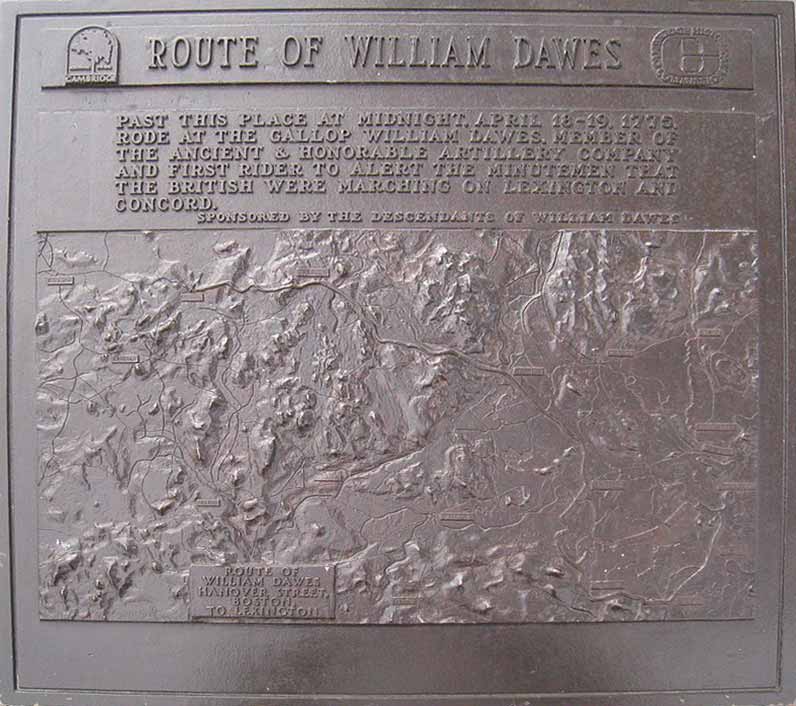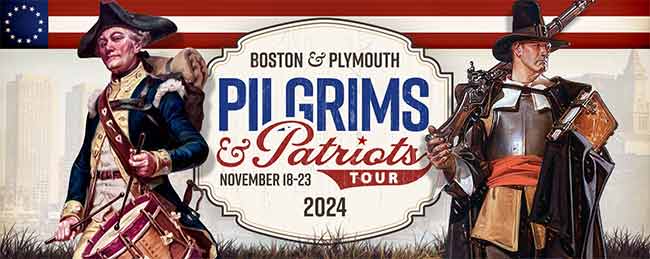
The Midnight Ride of Paul Revere, April 18, 1775
 t seems to be a prized joy of the modern historian to point out the holes in older narratives that were never considered pure history anyway, but were instead held as preserved and admired portions of a greater tale—usually with the intent of the future generations catching not just the facts, but the spirit of an event. So it is with the story of Paul Revere’s Ride. t seems to be a prized joy of the modern historian to point out the holes in older narratives that were never considered pure history anyway, but were instead held as preserved and admired portions of a greater tale—usually with the intent of the future generations catching not just the facts, but the spirit of an event. So it is with the story of Paul Revere’s Ride.

Statue of Paul Revere by Cyrus E. Dallin, in the Paul Revere Mall,
North End, Boston, Massachusetts

Henry Wadsworth Longfellow (1807-1882)
|
When in 1860 America’s beloved poet, Henry Wadsworth Longfellow, set out to write his famous poem commemorating one of the first acts of American valor, he did so from his home in Boston; one that had served as George and Martha Washington’s headquarters during the city’s siege in 1776. The history was thick around him, the times of Revolution far enough removed for all those who had lived it to be dying away, and a new generation was rising up who would in a year’s time spill each other’s blood in our tragic civil war. Paul Revere had already given his account of the ride; Longfellow sought to evoke the old urgency for preserving our rights and liberties.

The Longfellow National Historic Site—also known as the Vassall-Craigie-Longfellow House, in Cambridge, Massachusetts—was George Washington’s headquarters for 10 months during the American War for Independence, and later home of noted poet
Henry Wadsworth Longfellow for nearly fifty years
Two men rode out on the night of April 18, 1775: Paul Revere and William Dawes. Both men belonged to the Sons of Liberty and had been working with the Committee of Correspondence to carry secret and “treasonous” messages between freedom advocates throughout the colonies. On this night, their mission became more dire. They were tasked with alerting the local militia around Boston that the ever more hostile British regulars were marching to seize their powder and arms. They succeeded in their rides above and beyond expectations, and the militia who turned out to hold their own on Lexington Green would become credited with firing the first shots of the American Revolution.

A detailed map showing not only the route of Paul Revere, but also that of William Dawes and yet another rider, Samuel Prescott
In Longfellow’s poem, Dawes is not mentioned, nor Revere’s capture before he could arrive in Concord, and there are a sprinkling of other inaccuracies that rankle those who cannot find space for ethos in the recounting of the past. What it does retain is a stirring invitation to imagine the risk and fervor of those early days, and the willingness of our average men and women to expend themselves for a common cause.

A bronze plaque, commemorating the simultaneous ride of the long-forgotten William Dawes

One of the lanterns which hung “aloft in the belfry-arch” in Old North Church the night of Paul Revere’s storied ride
|
Listen, my children, and you shall hear
Of the midnight ride of Paul Revere,
On the eighteenth of April, in Seventy-Five:
Hardly a man is now alive
Who remembers that famous day and year.
He said to his friend, “If the British march
By land or sea from the town to-night,
Hang a lantern aloft in the belfry-arch
Of the North-Church-tower, as a signal-light,—
One if by land, and two if by sea;
And I on the opposite shore will be,
Ready to ride and spread the alarm
Through every Middlesex village and farm,
For the country-folk to be up and to arm.”
Read the full poem >

Image Credits:
1 Paul Revere sculpture (wikipedia.org)
2 Henry Wadsworth Longfellow (wikipedia.org)
3 Longfellow National Historic Site (wikipedia.org)
4 Map of Midnight Rides (wikipedia.org)
5 William Dawes Plaque (wikipedia.org)
6 Old North Church Lantern (wikipedia.org)
|







